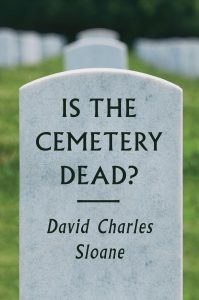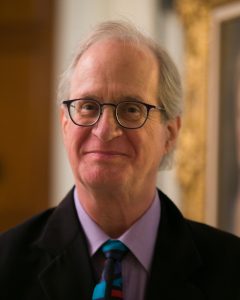Beyond the cemetery gates: 6 questions for David Charles Sloane about cemeteries and the past and future of memorials


David Charles Sloane’s Is the Cemetery Dead? has attracted notice for its thorough and empathetic survey of emerging trends in how we mourn our loved ones. The Los Angeles Review of Books called it “a levelheaded report on the death care industry,” while Publishers Weekly praised the “personal experience and knowledge” that Sloane interweaves with history and proclaimed the book to be “a great overview of mourning rituals in modern American culture.”
We sent David six questions—one, let’s say, for every foot deep that tradition calls for a grave to be dug . . .
Is the Cemetery Dead? details what you call the “changing cultural landscape of death and commemoration” by exploring such nontraditional mourning rites as ghost bikes, memory tattoos, and online memorials. Are there any of these new rituals that you find particularly moving or appealing?
As a professor of urban planning, I am especially affected by ghost bikes, the spectral white bicycles placed along the roadway at the site of the death of a cyclist. American cities too often have been developed for cars, not people. Over the last half-century, reformers have tried to change that, and make our cities more multi-modal—a place where you can drive, ride, and walk. The ghost bikes are a poignant reminder that we still have a long way to go to reach what is known as Vision Zero, the movement to have zero pedestrian and cyclist deaths.
One of the most powerful things about everyday memorials is one comes upon them without preparation. I was walking through our local park, and a roadside shrine to a young man who had drowned in the lake was filled with photographs, candles, and notes from family and friends. The emotional pathos they represent always affects me.
Many people are drawn to cemeteries less for purposes of grieving than for the singular mood and ambience a cemetery offers, as well as for their unique way of letting us commune with lived human history. Do you have favorite cemeteries, either in the US or abroad?
I have been to dozens, if not hundreds of cemeteries around the world, and many are fascinating. My dad’s cemetery in Syracuse, NY, has given me hundreds of hours of enjoyment from hiding from invisible invaders as a child to developing an abiding love of sculpture. I decided to start working on cemeteries after a research trip to Mount Auburn Cemetery in Cambridge, Mass. I have been back a lot—my wife is interred there—and the cemetery is simply beautiful, especially in the transitional spring/fall seasons. I first went to Pere Lachaise in Paris when the Parisians were up in arms about the vandals painting arrows to Jim Morrison’s gravesite, but have come back many times because of the stories of the Communards, Allan Kardec, and dozens of other famous people and fabulous monuments. Very much more recently, I went to the Ramsey Creek Preserve in South Carolina. The calmness of the space is remarkable, and the people creating/maintaining it were so generous. The University of Southern California sponsored a tour at Green-Wood Cemetery in Brooklyn as part of the book launch, and I was reminded of the emotionally affective monuments like the one to Charlotte Canda, the teenager killed by an uncontrolled carriage. Finally, of course, Forest Lawn Memorial Park (Glendale), which both disturbs and amazes me with its themed memorial gardens, mausoleum, and art shows. But, you can find interesting cemeteries pretty much anywhere. I love the colonial American graveyards with their upright sentinels, but not more than the rococo marvels in Buenos Aires, the perfectly quiet grounds in Bermuda, or the ethnic mosaic of Evergreen Cemetery in East Los Angeles. The range of the types is stunning, and what they have to offer in terms of nature and culture is startling.
Is the Cemetery Dead? positions itself alongside previous books on the US funeral industry, notably Jessica Mitford’s The American Way of Death, to which your book could be seen as a kind of update. What books would you recommend to readers interested in exploring these topics further?
Mitford’s book is stunning, and amazingly still relevant. For others not mentioned here, check out the selected readings at the end of my book. The most honored recent book is Thomas Laqueur’s Work of Death. Very detailed, very long, but quite rich with information and analysis. I very much liked Ken Worpole’s Last Landscapes, while Thomas Lynch’s books on undertaking are marvelous. Little has been written about natural burial, but you can look at the books, blogs and other venues for Caitlin Doughty and Megan Rosenbloom, who advocate for a good death. On everyday memorials, I really found Martha Cooper/Joseph Sciorra’s work on RIP memorials really insightful. Other people to look up are Drew Gilpin Faust, Peter N. Stearns, Pamela Roberts, Jack Santino, Holly Everett, and Tony Walter. My first book is out of print, but still worth reading—The Last Great Necessity: Cemeteries in American History (1991).
Your upbringing—as the child of a cemetery superintendent—is certainly unique, but you ultimately chose a path away from the family trade and now teach in the University of Southern California’s Sol Price School of Public Policy. What led you to your academic and professional career?
My mother said she believed I would be an historian when I was six because I was so enthusiastic in my biography and other history reading. I never seriously considered any other path after writing a senior thesis at U Wisconsin (Madison) on the portrayal of the city in American utopian novels. Finding the cemetery as a topic was serendipity. I read a wonderful book by Thomas Bender (Toward an Urban Vision) that referenced cemeteries, and thought, hmm, wonder what else has been written about them, and found almost nothing. So, the journey began.
Expanding upon the previous question: Do you find any links between your early experiences and what has become the focus of your career?
I used to deny any connection since people where quite suspicious of my relationship to the “industry.” One of the few negative reviews of my first book raised that issue. But now, I am less concerned. Growing up in a cemetery, watching people deal with their grief, handling the dead, fixing vandalized monuments—all prepared me to look analytically at these issues. For the first book, my dad’s reputation gave me entrée to many cemeteries, and even with this book, his memory lingers. Overall, I would have to say the first time someone introduced me as “the cemetery guy,” I was definitely taken back, but now I am proud that I helped make the cemetery, and the issues surrounding its history, a more visible element of historical study.
What are you reading currently and what do you plan to read next?
Finishing a book is exhausting, so for quite a while I was reading mysteries and novels. I recommend Eva Dolan’s thriller, This is How it Ends, about gentrification and murder in London, which I read for a USC Bedrosian Center podcast. Beyond that, I have mostly been reading manuscripts for colleagues, articles on planning history I might use in class, and an occasional newspaper article or scholarly journal article on dying, ghost bikes, and natural burial—the topic seems very difficult for me to step away from!